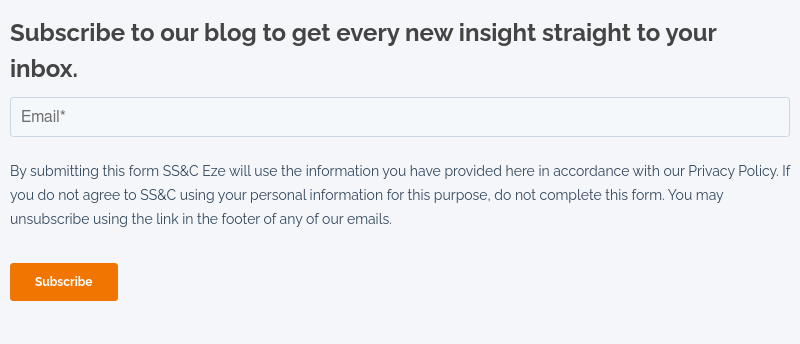How investment managers are using modern OMS technology to streamline workflows, reduce costs, and operate more effectively
Unpredictable Market Outlook Puts Focus on Front Office Technology
In recent years, the term "unprecedented" has been frequently used to describe market behavior. Investment managers have witnessed a gamut of events, from the depths of plunging stocks and bonds and the anomaly of oil futures dipping into negative territory to the peaks marked by the emergence of cryptocurrencies and record-breaking highs of major indexes.
As investment managers navigate these changes, many turn to technology to help create operational and cost efficiencies for their firms, capture more opportunities, and enhance their bottom lines. For the clients I speak with, the Order Management System (OMS) is one such tool.
And for a good reason. The OMS has been developed to include the features investment managers rely on to implement their investment ideas quickly and accurately. These features include real-time analytics, dynamic compliance, access to liquidity networks, and reliable allocation.
But as we look at the fast-changing markets – and the challenges many firms have faced over the last few years – I increasingly see a need for investment managers to go beyond the basic OMS. Today, generating alpha requires the help of a next-generation OMS.
Based on my 10 years of experience and the hundreds of clients I have worked with, here are 4 next-generation features a front office solution should have to help investment managers succeed in uncertain markets.
Operational Parity Across Instruments to Simplify Assets Class Expansion
In their quest to keep pace with their peers, I see many investment managers diversifying their asset classes.
For example, growth related to exchange-traded funds (ETFs) has made them increasingly attractive. And, after what could be called a tumultuous time for cryptocurrency, enhanced governance and due diligence mean more investment managers are seeking opportunities in digital currencies.
To be successful with asset class expansion requires investment managers first to ask this fundamental question: can their existing technology support these new asset types? If it can’t, these new asset classes may introduce labor-intensive processes that increase operational risks and costs – and eliminate growth potential.
That’s where a next-generation OMS comes in. These modern systems can handle the unique requirements of each instrument while offering continuity in the look, feel, and institutional-level performance investment managers require when managing less traditional asset classes.
Access to Advanced Trade Automation to Increase Investment Efficiency and Empower Employees
When they were first launched, the OMS enabled investment managers to track orders negotiated over the phone and improve paper-ticket-based recordkeeping. Much has changed since then, but the OMS's function remains the same at its core: automating manual processes.
One way a next-generation OMS does this is by aligning its robust allocation, modeling, and compliance functionality with the EMS’s.
With this connectivity, investment managers can program decisions once left to buy-side traders into their next-generation OEMSs. Examples include leveraging functionality to auto-route low-touch orders and "trade by exception," in which traders receive notifications to review orders that deviate from pre-defined criteria.
Firms also leverage the OMS to automate operational tasks, like trade rules, merging, and automatic finalization.
Together, these advanced automation features improve trade efficiency and enable traders to focus on high-touch orders while having confidence that potentially risky or unusual orders will be flagged.
However, trade automation doesn't just improve operations; it also helps investment managers attract and retain top talent.
Automating a job's mundane parts frees employees to focus on more challenging and rewarding work. And when employees focus on the interesting parts of their work, they’re more likely to be engaged and committed to their success and the growth of the firm.
Investment Ecosystem Architecture That Decreases TCO
In today's market, many investment managers look closer at their investment technology's Total Cost of Ownership (TCO). This analysis is critical because it illuminates how their current budget is allocated while highlighting what levers they can pull to reduce costs.
For investment managers seeking to reduce the TCO of their investment technology, a next-generation OMS with access to an investment ecosystem has become vital.
An investment ecosystem is a network of investment solutions connected via an open, vendor-neutral architecture. With access to an investment ecosystem, investment managers can tie together workflows across systems and partners into a single, seamless investment experience.
Access to an investment ecosystem also means investment managers can work with just one or a small handful of vendors for their front-to-back technology. As the needs of their firms evolve, they can tap into a range of plug-and-play solutions to adopt new features and functionality.
With an open architecture and access to a range of plug-and-play solutions, the modern OMS streamlines investment in technology, saving investment managers time and money by avoiding costly upgrades, piecemeal integrations, and lengthy implementations.
A Tenured Service Team Equipped to Handle the Demands of Front-office Users
In fast-changing markets, being passed from support team to support team in search of a solution or waiting days for a vendor to call back can mean delays and missed opportunities.
To be successful, investment managers need a strong partner with expertise and responsiveness they can count on. A next-generation OMS provider offers service that supports its clients as their firms grow and change.
Their service teams are comprised of experienced professionals who know the requirements of an investment firm and the industry. Tenure is an excellent way to measure both capabilities. Working with someone with more than a couple of years of experience means they have likely seen it all before and understand both the urgency and technicalities of the front office.




